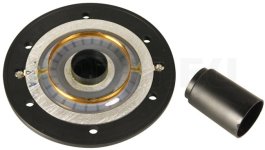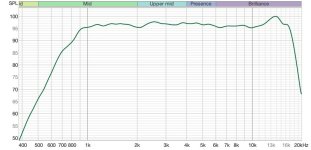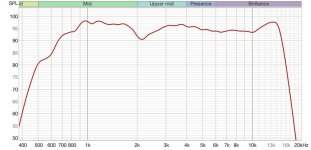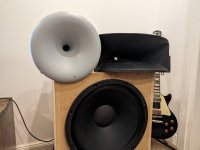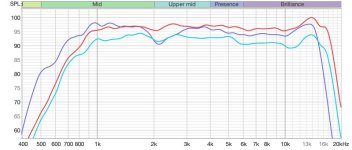@mabat: I have a doubt about potentially using this driver with the EXAR 400 waveguide (as another driver, I have a BMS 4550 waiting to be used with this waveguide).
I have been planning to insert a 3D printed conical adaptor into the Rosso 65 CDN-T driver (to convert it from a 1.4inch exit to a 1inch exit) till the phase plug exit and match the exit angle to the 14-degree (I think) entry angle into the EXAR 400. Would such a thing have any hope of working properly?
Edit: I just saw the comment about the straight sided tube extension into the driver in your previous comment. Maybe I will try that.. 🙂
I have been planning to insert a 3D printed conical adaptor into the Rosso 65 CDN-T driver (to convert it from a 1.4inch exit to a 1inch exit) till the phase plug exit and match the exit angle to the 14-degree (I think) entry angle into the EXAR 400. Would such a thing have any hope of working properly?
Edit: I just saw the comment about the straight sided tube extension into the driver in your previous comment. Maybe I will try that.. 🙂
I'd say it's worth a try at least. If you measure the geometry (both diameters and depth) I can adapt the EXAR kit for this driver.
I think you described it quite well. Basically the woofer in this box is too directive to match the waveguide towards the crossover frequency.Personally - again, feel free to correct me if my approach is a bad idea
The two nulls in the pattern that can be seen at 150 degrees are created from the diffraction off the back corners of the enclosure. These can be useful in creating directivity or can make it lumpy like here. In your modified box a single deep null was changed for two smaller less deep ones. There are many little box tricks that can be used to try and bend the directivity to where you want it.
Thank you @mabat. I will try to get these measurements 🙂I'd say it's worth a try at least. If you measure the geometry (both diameters and depth) I can adapt the EXAR kit for this driver.
Do you mean the VACS that I had provided or Cinnamonrolls’? Because the data that I showed is for the tweeter only, a circa 130/140 degree horizontal pattern 2-profile waveguide. There is no woofer data.I think you described it quite well. Basically the woofer in this box is too directive to match the waveguide towards the crossover frequency.
Although I agree that maybe a 8-inch woofer was better for such a wide pattern, I have the 10-inch and I found I should be able to closely match the wide waveguide with the 10-inch woofer around 1 kHz, where they commonly share a DI of about 6 dB.
Thanks so much @CinnamonRolls, great tutorial. I will give it a try next time!
Ignore what I saidDo you mean the VACS that I had provided
Does anyone have a photo of the exit of the ROSSO-65CDN-T compression driver?
It looks like a nice driver, I only wonder how well it is suited for usage directly from the phase plug exit...
Maybe on a related note, I've stumbled upon a photo of a BMS 4554L replacement diaphragm that shows the diaphragm, plus what may look like an extension piece to be connected to the short exit duct of the phase plug on the diaphragm assembly. I'd speculate the BMS 4454 (not sure what the L suffix signifies) is the 1.4" exit version of the 1" exit BMS 4550, as in the diaphragms might be the same (but maybe with different lengths of the phase plug exits on the diaphragm assemblies), and there's an extension piece is to connect to the 1.4" exit in the top plate of the driver. This leads to the idea of what if one could print and LF extension plug instead to connect to the phase plug on the diaphragm assembly.
(Photo: https://www.musikhaus-korn.de/en/bm...s4554l-14-hochtontreiber-80-w-8-ohm/pd/128285)
Attachments
Hello, people! I've been using ATH 4.8.2 for a couple of weeks—congratulations on this wonderful software! I've been experimenting with some scripts posted on the forum and importing some .msh files to Akabak to simulate various examples. However, I've been trying for a few days now to create a script for a CE HORN (conical-exponential horn) based on the article at https://www.grc.com/acoustics/an-introduction-to-horn-theory.pdf and https://www.xlrtechs.com/dbkeele.co...AES Preprint) - Whats So Sacred Exp Horns.pdf. How can I write a script to create an exponential throat section with a mouth radius "r" determined by the formula to smoothly transition to the conical section that follows? The idea is to have an exponential throat section until it reaches a radius of "r," and from there, the conical section with straight walls and a square mouth begins.
I've been researching, and I think that using the R-OSSE formula could allow me to make the throat adapter the exponential section. Could this be possible?
P.D: Sorry for my poor English; it's not my native language 🙂
I've been researching, and I think that using the R-OSSE formula could allow me to make the throat adapter the exponential section. Could this be possible?
P.D: Sorry for my poor English; it's not my native language 🙂
rsacustica, I suggest to add an exponential profile you want as another curve into the desmos graph with R-OSSE and the adjust R-OSSE parameters to have the best fit to that curve:
- https://www.desmos.com/calculator/lxpie8bbpa
- https://www.desmos.com/calculator/lxpie8bbpa
I would suggest to simply add a conical extension to a R-OSSE waveguide. The expansion of a narrow cone won't be very different from exponential I think - no need to be that fussy. At least as long as the diameter small. I want to make an analysis of different extension shapes (to see its effect on directivity and throat impedance), I just have to find a while...
Hi guys,
Here are some measurements of HF10AK with two dif. horns, the first one that I've got seems like a vintage one, dont't know any specs. and the second one it's a printed ST260.
As you can see from the graphs, the HF10AK "magic" dip at 2k it's a lot less pronounced 😉!
This week, I will start to print the new ATH-280EX as soon as I get a new nozzle for my printer....can't wait to measure that one!!!
Here are some measurements of HF10AK with two dif. horns, the first one that I've got seems like a vintage one, dont't know any specs. and the second one it's a printed ST260.
As you can see from the graphs, the HF10AK "magic" dip at 2k it's a lot less pronounced 😉!
This week, I will start to print the new ATH-280EX as soon as I get a new nozzle for my printer....can't wait to measure that one!!!
Attachments
I wouldn't have expected that, but good for you 🙂As you can see from the graphs, the HF10AK "magic" dip at 2k it's a lot less pronounced !
So do I. Maybe at least a few more off-axis angles would be even better.....can't wait to measure that one!!!
@mabat is that likely a function of the throat impedance of the ST260 peaking at the ~2.3khz region?it's a printed ST260.
As you can see from the graphs, the HF10AK "magic" dip at 2k it's a lot less pronounced 😉!
ST260
I doubt it.
What's peaking is the imaginary part (acoustic mass), not contributing to the radiation. And even if the real (Re) part was peaking, I would still doubt it.
What's peaking is the imaginary part (acoustic mass), not contributing to the radiation. And even if the real (Re) part was peaking, I would still doubt it.
And is it for better or worse? 🙂The old horn sounds metallic, can't explain, even my wife has noticed that....
Often, it's difficult to make metallic sources in a recording sound metallic enough....
The ATH-280EX should add "a few" dB around 800 - 1k, I'm really curious how that turns out.
BMS 4554 has quite a long, rather wide-angled, conical exit, starting with what can be seen in the picture, which is a pretty small diameter. I doubt a bit that a longer extension would add to output significantly in this case. But we still can't simulate this with any accuracy, so it's just a guess. Maybe it's worth a try. At this point it's all about a will to experiment.Maybe on a related note, I've stumbled upon a photo of a BMS 4554L replacement diaphragm that shows the diaphragm, plus what may look like an extension piece to be connected to the short exit duct of the phase plug on the diaphragm assembly. [...]
(I have no idea what 4554L means, or what is that black cylindrical part in the photo. I thought about a centering jig but who knows.)
@sheeple Here's a teardrop shaped enclosure. Straight sides + sharp edges so it's easier to see where it makes the contour lines wavy. Included in attached Zip. Also, comparing it to a standard box shape simulation helps you judge where your shaped box is either helping or hurting you.
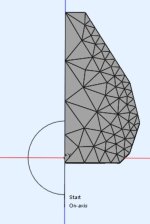
180 degree Horizontal / 360 degree Vertical
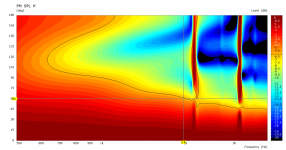
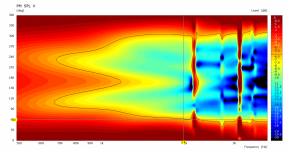

180 degree Horizontal / 360 degree Vertical


Attachments
btw, I don't think the teardrop shape is so great for your flatter DI waveguide. Seems to be a popular shape so I posted it.
- Home
- Loudspeakers
- Multi-Way
- Acoustic Horn Design – The Easy Way (Ath4)
